Quad/Graphics Bundle
How Did Quad/Graphics Revolutionize the Printing Industry?
Ever wondered how a small printing company could transform into a global marketing powerhouse? The story of Quad/Graphics, a company built on innovation and strong relationships, is a compelling journey of adaptation and growth. From its humble beginnings in 1971, Quad/Graphics has consistently redefined the Quad/Graphics SWOT Analysis. Discover how this printing company navigated the complexities of the printing industry to become a leader in integrated marketing solutions.
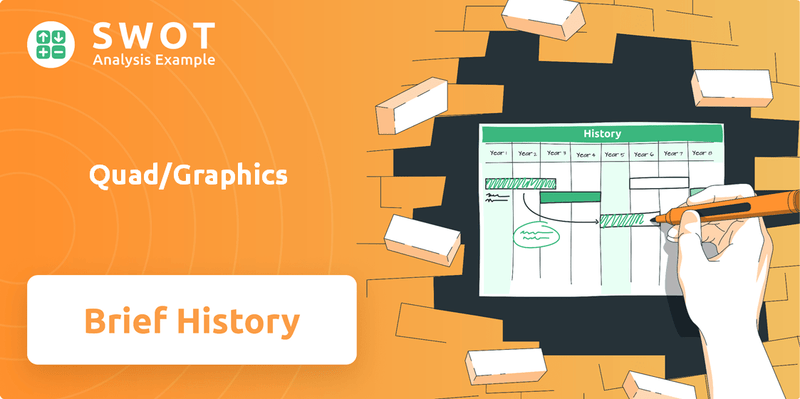
Founded by Quad/Graphics founder Harry V. Quadracci, the company's commitment to employee well-being and customer satisfaction set it apart from the start. This people-centric approach, combined with a relentless pursuit of "a better way," fueled its expansion. Explore the Quad Graphics history and understand how Quad company evolved from a local printer to a comprehensive marketing services provider, impacting the landscape of modern business.
What is the Quad/Graphics Founding Story?
The story of Quad/Graphics, a prominent printing company, began on July 13, 1971. The company was established by Harry V. Quadracci, along with eleven co-founders, marking the start of a new chapter in the printing industry.
Harry V. Quadracci's vision was shaped by his experiences and observations within the printing sector. He aimed to create a company culture that differed from the existing norms, emphasizing mutual respect and collaboration between management and employees. This foundational principle set the stage for Quad/Graphics' future growth and impact.
Quad Graphics history is rooted in the vision of its founder, Harry V. Quadracci, who sought to transform the printing industry. He identified the adversarial relationships prevalent in the industry as a key issue, aiming to foster a more collaborative environment.
- Quad/Graphics founder, Harry V. Quadracci, secured a $35,000 second mortgage on his home to launch the company.
- The company's initial focus was on commercial printing, particularly magazines and catalogs.
- The first plant and headquarters were established in an abandoned millwork factory in Pewaukee, Wisconsin.
- The company's early success was built on a commitment to employee welfare, which set it apart from industry standards.
The early years of Quad Graphics company were marked by a commitment to innovation and a focus on building a strong company culture. Quadracci's approach to business, which emphasized employee well-being, helped to establish a distinctive identity for the company. The initial investment and the choice of location reflected the company's modest beginnings, yet its ambitions were significant.
The founding team's expertise in printing, combined with Quadracci's innovative spirit, was crucial in redefining the operational and cultural standards of the printing industry. This commitment to a 'better way' extended to taking care of employees and their families, a stark contrast to the industry norms he left behind. This vision laid the foundation for Quad/Graphics' distinctive culture.
Quad/Graphics SWOT Analysis
- Complete SWOT Breakdown
- Fully Customizable
- Editable in Excel & Word
- Professional Formatting
- Investor-Ready Format
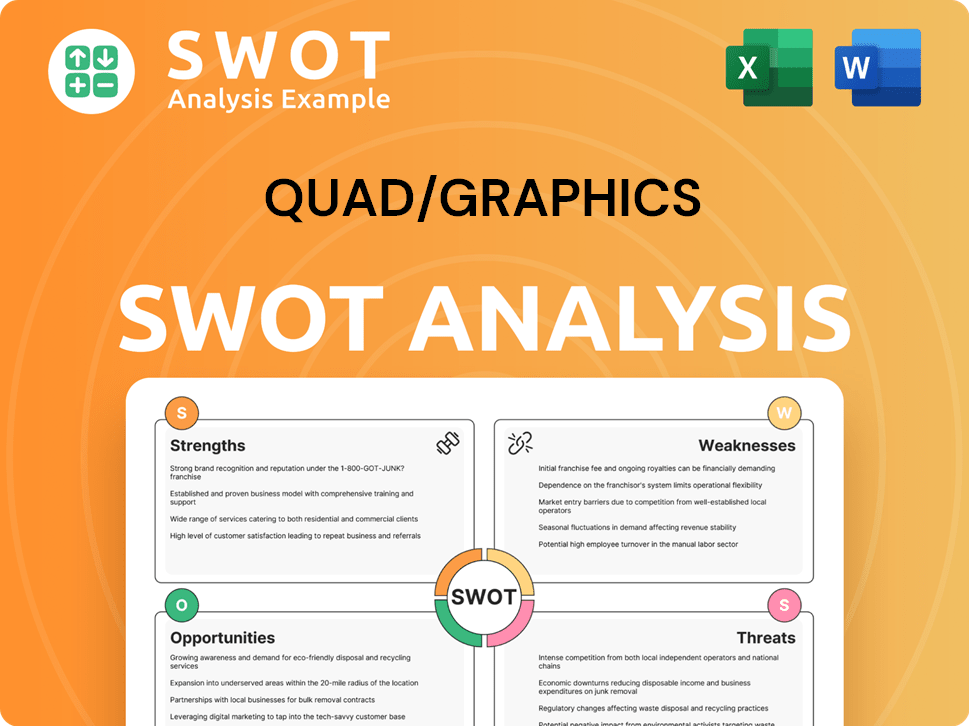
What Drove the Early Growth of Quad/Graphics?
The early years of the Quad/Graphics company were marked by significant growth and expansion within the printing industry. The company quickly increased its operational capacity and broadened its client base. This period saw the establishment of key divisions and the adoption of innovative practices to enhance productivity and service offerings.
By 1973, the Quad/Graphics company had expanded to employ 25 people, generating $2.8 million in sales. That same year, the company founded Duplainville Transport, which later became part of Quad/Transportation Services, to offer distribution services. The company also invested in new printing presses, including a second press in 1975.
Early clients included the Investor magazine and the Fishing Facts magazine. A contract for The Art of Walt Disney art book provided credibility for its high-quality, four-color work. In 1974, Quad/Graphics adopted a three-day, 12-hour-shift work week to maximize productivity. By 1979, the company had grown to 300 employees and operated six presses.
Quad/Graphics expanded its services by establishing Quad/Tech in 1979 for manufacturing press and bindery controls, and Enterprise Graphics (later Quad/Imaging) for prepress services. By the mid-1990s, the company was printing major magazines like People and Sports Illustrated, and catalogs for LL Bean and Lands' End. The company's Mission, Vision & Core Values of Quad/Graphics also played a key role in this expansion.
International expansion began in 1996 with an interest in a commercial printer in Buenos Aires, Argentina, followed by Sao Paolo, Brazil, in 1997, and an equity stake in Winkowski, Poland, in 1998. By 2002, Quad/Graphics had approximately 14,000 employees, $2 billion in annual sales, and 15 plants across three continents, solidifying its position as the largest privately owned printing company globally.
Quad/Graphics PESTLE Analysis
- Covers All 6 PESTLE Categories
- No Research Needed – Save Hours of Work
- Built by Experts, Trusted by Consultants
- Instant Download, Ready to Use
- 100% Editable, Fully Customizable
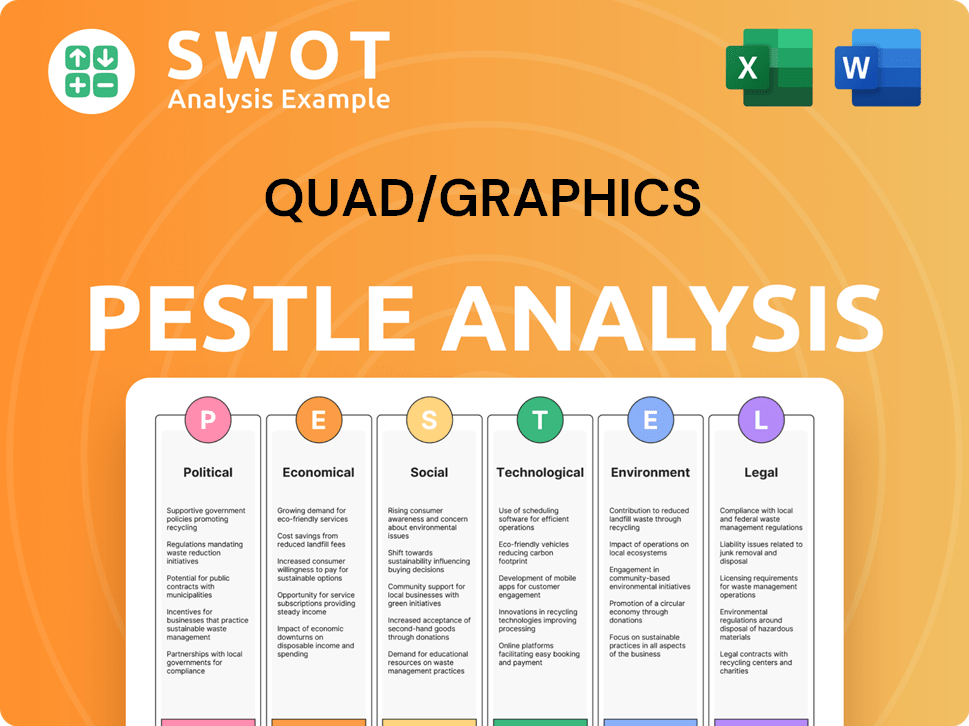
What are the key Milestones in Quad/Graphics history?
The history of the printing company, Quad/Graphics, is marked by strategic decisions and adaptations within the printing industry. The company's journey includes significant acquisitions, technological advancements, and shifts in business focus to meet market demands.
| Year | Milestone |
|---|---|
| 1985 | Quad Graphics invested over $50 million in gravure presses to secure the Playboy contract, enhancing image quality. |
| 1990 | Quad/Photo was launched, making Quad one of the first commercial printers to offer digital photography services. |
| 1993 | A high-speed Ferag drum stitcher was acquired to improve efficiency. |
| 2010 | The acquisition of Worldcolor made Quad the second-largest printer in the Americas and led to its initial public offering. |
| 2015 | BlueSoho was repositioned to include mobile marketing and media planning. |
| 2024-2025 | Expansion of the In-Store Connect retail media network, including onboarding new grocery clients. |
Quad/Graphics has consistently embraced innovation to stay competitive. Early advancements included the adoption of Heidelberg Harris press technology and the integration of digital photography services. More recently, the company has launched platforms like At-Home Connect and expanded its retail media network.
In 1985, Quad/Graphics invested heavily in gravure presses to secure contracts, notably with Playboy, enhancing image quality. This technology used engraved copper cylinders, showcasing a commitment to superior printing capabilities.
Quad/Photo was launched in 1990, making Quad/Graphics one of the first commercial printers to offer digital photography services. This move showcased the company's early adoption of digital technologies.
The adoption of Heidelberg Harris press technology in the early 1990s improved printing efficiency and quality. This investment enabled Quad Graphics to meet growing demands.
In 1993, the acquisition of a high-speed Ferag drum stitcher was another step to improve efficiency. This technology streamlined the binding process, increasing production speed.
Quad/Graphics launched At-Home Connect, an intelligent, automated direct mail platform. This platform helped the company to provide more efficient direct mail services.
The expansion of the In-Store Connect retail media network is a recent innovation. This expansion includes onboarding new grocery clients in 2024 and 2025, driving new revenue streams.
The printing industry has presented several challenges for Quad/Graphics. Declining print volumes and lower paper sales have impacted the company's financial performance. The company has responded by diversifying its services and focusing on cost reduction.
Quad/Graphics has faced declining print volumes due to changing media and advertising trends. This decline has necessitated strategic adjustments to maintain profitability.
Lower paper sales have negatively affected the company's financial results. The company has responded by diversifying its services and focusing on cost reduction.
The loss of a large grocery client impacted agency solutions sales. This loss highlighted the need for diversification and the importance of client retention.
The divestiture of its European operations in Q1 2025 contributed to a decrease in net sales. This strategic move reflects the company's focus on core markets.
In Q1 2025, net debt increased to $463 million, which is typical due to seasonal working capital timing. This is a common financial pattern for the company.
Despite challenges, Quad/Graphics has improved its Adjusted EBITDA margin to 8.4% in 2024, up 48 basis points from 7.9% in 2023. The company has also reduced its net debt significantly.
For more insights into the company's strategic direction, consider reading about the Growth Strategy of Quad/Graphics.
Quad/Graphics Business Model Canvas
- Complete 9-Block Business Model Canvas
- Effortlessly Communicate Your Business Strategy
- Investor-Ready BMC Format
- 100% Editable and Customizable
- Clear and Structured Layout
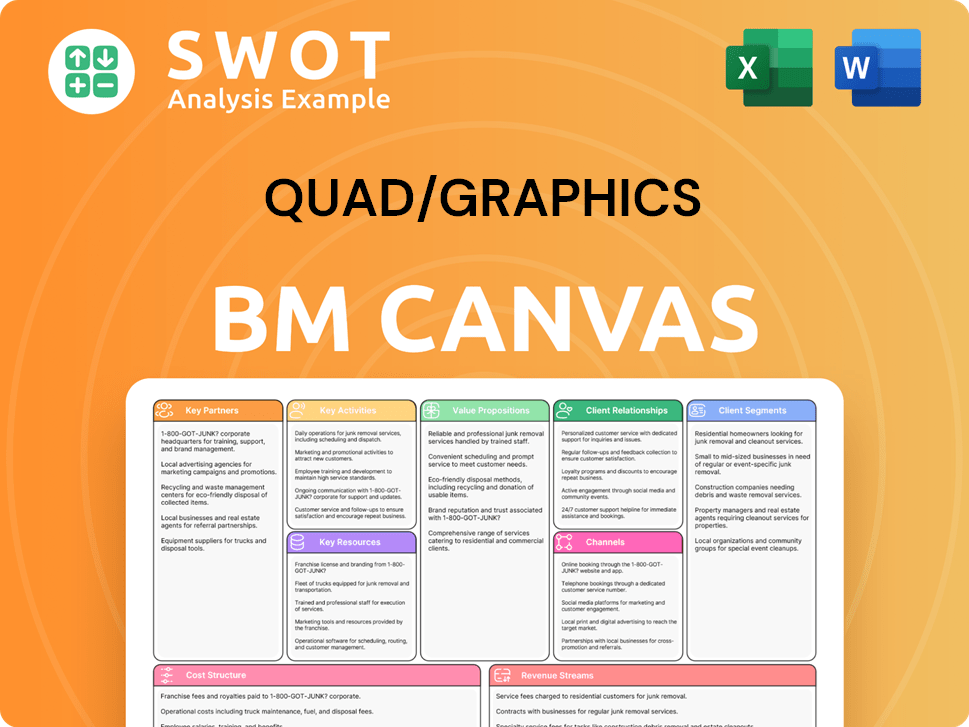
What is the Timeline of Key Events for Quad/Graphics?
The Quad/Graphics history is marked by significant milestones that showcase its evolution and adaptation within the printing industry. Founded by Harry V. Quadracci in 1971, the company quickly expanded, launching its first division, Duplainville Transport, in 1973. Investments in technology, such as the addition of a new Harris Graphics M1000 press in 1975 and the establishment of Quad/Tech in 1979, were crucial. The company also prioritized employee well-being, exemplified by the 1980 launch of Camp Quad. Strategic moves, including the 1985 investment in gravure presses for the Playboy contract and the 2010 acquisition of Worldcolor, shaped its growth. Further expansions into digital services with Quad/Photo in 1990 and international markets, starting in Latin America in 1996 and Europe in 1998, broadened its scope. The acquisition of Periscope in 2019 and DART Innovation in 2024, alongside the sale of its European operations in 2025, reflect its evolving strategy.
| Year | Key Event |
|---|---|
| 1971 | Harry V. Quadracci founded Quad/Graphics in Pewaukee, Wisconsin. |
| 1973 | Launched Duplainville Transport, marking its initial diversification. |
| 1975 | Added a new Harris Graphics M1000 press, enhancing its printing capabilities. |
| 1979 | Established Quad/Tech to manufacture computer-based press controls. |
| 1980 | Launched Camp Quad, an educational and recreational nature center for employees and clients. |
| 1985 | Invested over $50 million in gravure presses for the Playboy contract. |
| 1990 | Established Quad/Photo, offering digital photography services. |
| 1991 | Opened on-site daycare at Sussex headquarters. |
| 1996 | Began Latin American expansion with an interest in a printer in Buenos Aires. |
| 1998 | Expanded to Europe with an equity stake in Winkowski, Poland. |
| 2010 | Acquired Worldcolor and went public on the NYSE. |
| 2012 | Rebranded Winkowski as Quad/Graphics Europe. |
| 2019 | Acquired Periscope, an advertising firm, and began producing 100% of Condé Nast's titles. |
| 2024 | Acquired DART Innovation, an AI-based digital solutions provider. |
| 2025 | Completed the sale of its European operations. |
Quad/Graphics is transforming into a marketing experience company, aiming to diversify revenue streams. This strategic shift is crucial for adapting to the evolving printing industry and expanding its service offerings. This transformation includes a focus on digital solutions and enhanced customer engagement.
For 2025, the company anticipates full-year adjusted EBITDA between $180 million and $220 million. Free cash flow is projected to be between $40 million and $60 million. The company is targeting a net debt leverage of approximately 1.5x by the end of 2025, reflecting a focus on financial stability.
Quad/Graphics is investing in its data stack to drive new revenue through expanded audience intelligence and activation services. It is also enhancing platforms like At-Home Connect and building sales momentum for its In-Store Connect retail media network. Partnerships with Google Cloud are key to creating new AI-driven solutions.
The company anticipates net sales growth between 2027 and 2028, driven by its strategic initiatives. This growth is expected to come from diversified revenue streams and expanded services. The company's leadership remains confident in its vision and brand, continuing to innovate for clients.
Quad/Graphics Porter's Five Forces Analysis
- Covers All 5 Competitive Forces in Detail
- Structured for Consultants, Students, and Founders
- 100% Editable in Microsoft Word & Excel
- Instant Digital Download – Use Immediately
- Compatible with Mac & PC – Fully Unlocked
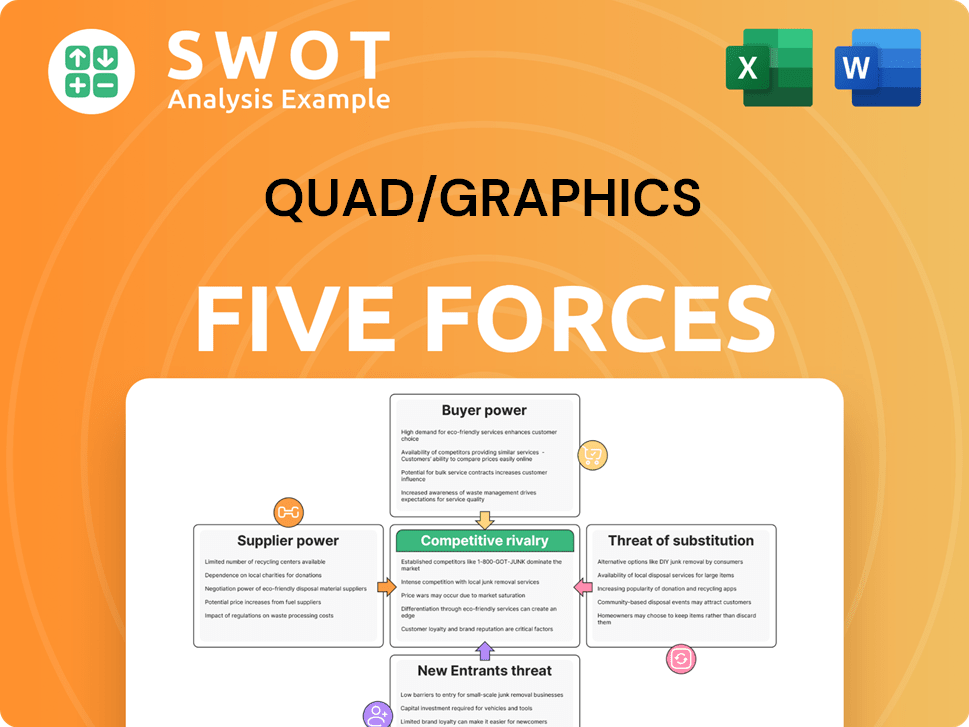
Related Blogs
- What is Competitive Landscape of Quad/Graphics Company?
- What is Growth Strategy and Future Prospects of Quad/Graphics Company?
- How Does Quad/Graphics Company Work?
- What is Sales and Marketing Strategy of Quad/Graphics Company?
- What is Brief History of Quad/Graphics Company?
- Who Owns Quad/Graphics Company?
- What is Customer Demographics and Target Market of Quad/Graphics Company?
Disclaimer
All information, articles, and product details provided on this website are for general informational and educational purposes only. We do not claim any ownership over, nor do we intend to infringe upon, any trademarks, copyrights, logos, brand names, or other intellectual property mentioned or depicted on this site. Such intellectual property remains the property of its respective owners, and any references here are made solely for identification or informational purposes, without implying any affiliation, endorsement, or partnership.
We make no representations or warranties, express or implied, regarding the accuracy, completeness, or suitability of any content or products presented. Nothing on this website should be construed as legal, tax, investment, financial, medical, or other professional advice. In addition, no part of this site—including articles or product references—constitutes a solicitation, recommendation, endorsement, advertisement, or offer to buy or sell any securities, franchises, or other financial instruments, particularly in jurisdictions where such activity would be unlawful.
All content is of a general nature and may not address the specific circumstances of any individual or entity. It is not a substitute for professional advice or services. Any actions you take based on the information provided here are strictly at your own risk. You accept full responsibility for any decisions or outcomes arising from your use of this website and agree to release us from any liability in connection with your use of, or reliance upon, the content or products found herein.